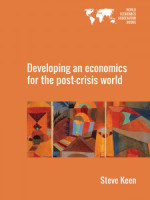One essential aspect of Minsky’s Financial Instability Hypothesis was the argument that there are two price levels in capitalism: consumer prices, which are largely set by a markup on the costs of production, and asset prices, which are determined by expectations and leverage. This argument originated with Keynes in Chapter 17 of the General Theory, when he noted that investment is motivated by the desire to produce “those assets of which the normal supply-price is less than the demand price” (Keynes 1936, p. 228), and expressed more clearly in “The General Theory of Employment”, where he argued that the scale of production of capital assets “depends, of course, on the relation between their costs of production and the prices which they are expected to realise in the market” (Keynes 1937, p. 217). Minsky significantly elaborated upon this point, and this – as much as his focus upon uncertainty – was a key point of divergence from the neoclassical interpretation of Keynes. The perception that the quantity of money determines the price level of capital assets, for any given set of expectations with respect to quasi-rents and state of uncertainty, because it affects the financing conditions for positions in capital assets, implies that in a capitalist economy there are two “price levels,” one of current output and the second of capital assets.
Topics:
Editor considers the following as important: Uncategorized
This could be interesting, too:
tom writes The Ukraine war and Europe’s deepening march of folly
Stavros Mavroudeas writes CfP of Marxist Macroeconomic Modelling workgroup – 18th WAPE Forum, Istanbul August 6-8, 2025
Lars Pålsson Syll writes The pretence-of-knowledge syndrome
Dean Baker writes Crypto and Donald Trump’s strategic baseball card reserve
One essential aspect of Minsky’s Financial Instability Hypothesis was the argument that there are two price levels in capitalism: consumer prices, which are largely set by a markup on the costs of production, and asset prices, which are determined by expectations and leverage. This argument originated with Keynes in Chapter 17 of the General Theory, when he noted that investment is motivated by the desire to produce “those assets of which the normal supply-price is less than the demand price” (Keynes 1936, p. 228), and expressed more clearly in “The General Theory of Employment”, where he argued that the scale of production of capital assets “depends, of course, on the relation between their costs of production and the prices which they are expected to realise in the market” (Keynes 1937, p. 217). Minsky significantly elaborated upon this point, and this – as much as his focus upon uncertainty – was a key point of divergence from the neoclassical interpretation of Keynes.
The perception that the quantity of money determines the price level of capital assets, for any given set of expectations with respect to quasi-rents and state of uncertainty, because it affects the financing conditions for positions in capital assets, implies that in a capitalist economy there are two “price levels,” one of current output and the second of capital assets. A fundamental insight of Keynes is that an economic theory that is relevant to a capitalist economy must explicitly deal with these two sets of prices. Economic theory must be based upon a perception that there are two sets of prices to be determined, and they are determined in different markets and react to quite different phenomena. Thus, the relation of these prices-say, the ratio-varies, and the variations affect system behavior. “When economic theory followed Sir John Hicks and phrased the liquidity preference function as a relation between the money supply and the interest rate, the deep significance of Keynesian theory as a theory of behavior of a capitalist economy was lost” (Minsky 1982, p. 79).
Over the very long term, these two price levels have to converge, because ultimately the debt that finances asset purchases must be serviced by the sale of goods and services – you can’t forever delay the Day of Reckoning by borrowing more money. But in the short term, a wedge can be driven between them by rising leverage.
Unfortunately, in modern capitalism, the short term can last a very long time. In America’s case, this short term lasted 50 years, as debt rose from 43 per cent of GDP in 1945 to over 300 per cent in early 2009. The finance sector always has a proclivity to fund Ponzi Schemes, but since World War II this has been aided and abetted by a government and central bank nexus that sees rising asset prices as a good thing.

